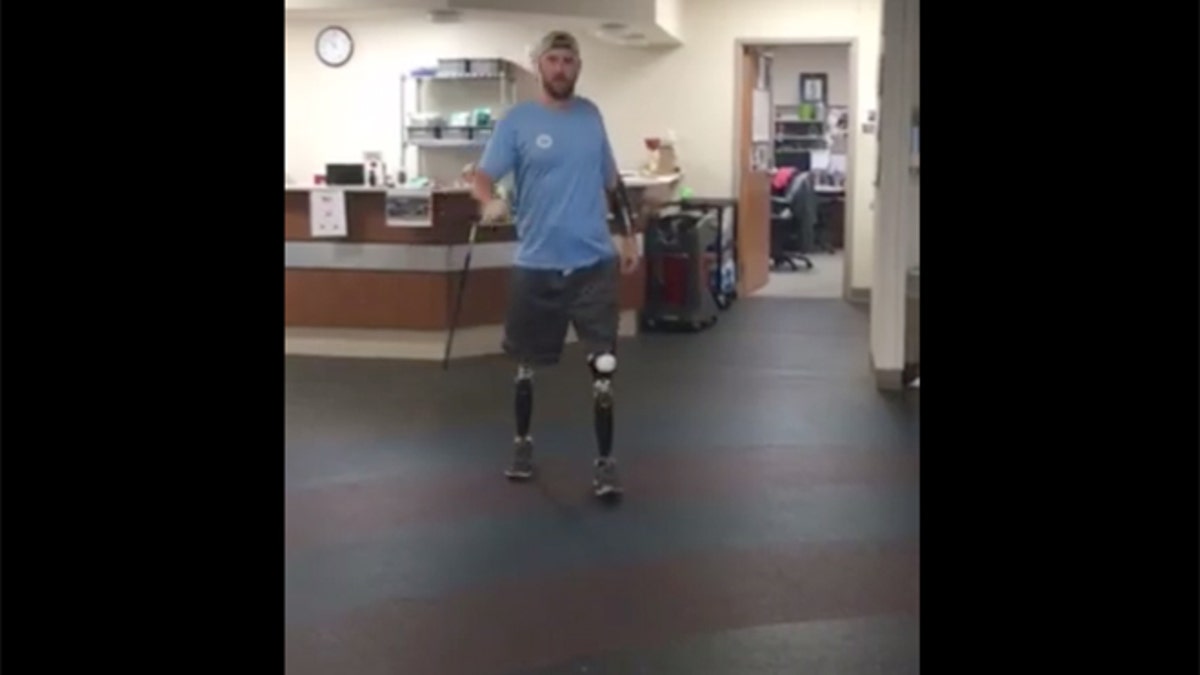Lounging by the pool or waking up in the middle of the night to use the bathroom aren’t what most able-bodied individuals would consider to be complicated tasks, but for bilateral amputees, the process of changing into their prostheses for these activities can be cumbersome. For injured service members— a record number reported major limb amputations in 2011— the transition back to civilian life also includes learning how to manage their new limbs.
Prior to the start of the conflict there wasn’t a large bilateral amputee population, and their level of care typically ended with an adaptable wheelchair, Dave Laufer, director of orthotic and prosthetic service at Walter Reed National Military Medical Center in Bethesda, Maryland, told FoxNews.com. But as more service members returned home with missing limbs, Laufer and his team were inundated with requests for something better than what was available.
“When you and I go home from work… you take your shoe off,” Dave Laufer, director of orthotic and prosthetic service at Walter Reed National Military Medical Center in Bethesda, Maryland, told FoxNews.com. “An amputee shoe is attached to his leg. When bilateral amputees take their shoes off they’re now sitting on a chair and they’re stuck.”
To stand upright for any task, amputees first have to roll a liner onto their residual limb, put on the prosthetic socket, then attach the socket to the rest of the prosthetic limb before standing up on both feet to ensure stability of the fit before walking again.
“It’s not a real comfortable process,” Laufer said.
Service members began turning to shorty feet, which were originally introduced to help amputees learn how to bear weight on their residual limbs. Shorty feet eilimate the need for liners and attachments, as they are specifically designed to fit the skin of the soldier's remaining limbs. Seeing the success of others in physical therapy, Laufer began receiving requests for more pairs from service members looking for an easy way to hang around the house.
One of the early pairs is believed to have been ordered for a service member who wanted to relax around the pool on his honeymoon without having to worry about getting his prostheses wet. Others use them to play with their kids around the house or simply as a way to perform a task in the middle of the night without having to ask others for help.
To get an ideal prosthesis, Laufer and his team turned to another department at Walter Reed headed by Dr. Peter Liacouras, director of services in the 3-D Medical Applications Center. Liacouras received the order and after discussion with Laufer and other staff members, 3-D printed the shorty feet in titanium alloy.
“It’s titanium alloy,” Liacouras told Foxnews.com. “We have a printer here that will use an electron-B melting process to print layer by layer out of titanium powder," Liacouras told FoxNews.com. "We’ve done over 70 pairs of shorty feet.”
The shorty feet prototype design underwent several remodeling processes, including the addition of a padded bottom to act as a sole of the foot. A military insignia can also be etched onto the model to indicate which branch a service member has served in.
A civilian prosthetic company saw the success of shorty feet and began manufacturing a version of them, which helps lighten the workload for Liacouras’ staff.
While shorty feet can provide the independence that some returning service members crave, they can also be a stepping stone for others on their path to recovery. Army Sgt. Adam Keys, 32, started walking on shorty feet before learning how to walk with another pair of prosthetic limbs.
On July 14, 2010, the vehicle Keys was traveling in through Kandahar, Afghanistan, hit an improvised explosive device (IED.) The blast cost Keys his left arm and both legs above the knee. He has since undergone more than 130 surgeries, meaning the shape, size and weight of his residual limbs have changed repeatedly, requiring numerous adjustments to his prostheses.
Keys was first fitted with shorty feet in 2012 when he was learning to keep his balance and stand upright again. After spending nearly two years in a hospital bed and wheelchair, he was anxious to be upright but wanted to be taller. He’s now fitted with “sidekicks,” which he said helps him walk easier and provide him with the height he was looking for. Sidekicks differ from shorty feet in that they have an artificial knee joint and act more like a full leg.
“Although [shorty feet] are great and you keep your balance and everything, you have to swing your hip out to walk,” Keys told FoxNews.com. “With these sidekicks, you walk naturally instead of swing your hip out, you walk as if you have knees without knees so I love it.”

Sgt. Adam Keys walks using his sidekicks. (Sgt. Adam Keys - One Step Forward)
Keys and his mother, Julie, now travel the country as motivational speakers. Julie was his caregiver for more than five years during his recovery. During his “One Step Forward” talks, he tells audiences that, while he enlisted in the Army on Sept. 14, 2008, on the date of his injury, July 10, 2014, his mother unknowingly enlisted, as well.
“People look at me and say how did I do it and I say ‘Hey, there’s 100 people behind me and one of them was my mother of course,’” Keys said.
Keys plans to use the sidekicks and shorty feet four to five days per week at home to complete yardwork and on special occasions like nights out or weddings. Other days he relies on his wheelchair. He also plans to use the sidekicks for his speaking occasions.
“Having these shorty and sidekick feet, I’m going to use my feet at home a lot more for sure,” Keys said. “Being able to stand to do anything is always much better.”
